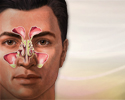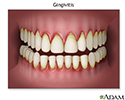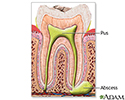Breath odor
Bad breath; Halitosis; Malodor; Fetor oris; Fetor ex ore; Fetor ex oris; Breath malodor; Oral malodorBreath odor is the scent of the air you breathe out of your mouth. Unpleasant breath odor is commonly called bad breath.
Considerations
Bad breath is usually related to poor dental hygiene. Not brushing and flossing regularly causes sulfur compounds to be released by bacteria in the mouth.
Some disorders will produce distinct breath odors. Some examples are:
- A fruity odor to the breath is a sign of ketoacidosis, which may occur in diabetes. It is a potentially life-threatening condition.
Ketoacidosis
Diabetic ketoacidosis (DKA) is a life-threatening problem that affects people with diabetes. It occurs when the body starts breaking down fat at a r...
 ImageRead Article Now Book Mark Article
ImageRead Article Now Book Mark Article - Breath that smells like feces can occur with prolonged vomiting, especially when there is a bowel obstruction. It may also occur temporarily if a person has a tube placed through the nose or mouth to drain their stomach.
Vomiting
Nausea is feeling an urge to vomit. It is often called "being sick to your stomach. "Vomiting or throwing-up forces the contents of the stomach up t...
 ImageRead Article Now Book Mark Article
ImageRead Article Now Book Mark ArticleBowel obstruction
Intestinal obstruction is a partial or complete blockage of the bowel. The contents of the intestine cannot pass through it.
 ImageRead Article Now Book Mark Article
ImageRead Article Now Book Mark Article - The breath may have an ammonia-like odor (also described as urine-like or "fishy") in people with chronic kidney failure.
Chronic kidney failure
Chronic kidney disease is the slow loss of kidney function over time. The main job of the kidneys is to remove wastes and excess water from the body...
 ImageRead Article Now Book Mark Article
ImageRead Article Now Book Mark Article
Causes
Bad breath may be caused by:
-
Abscessed tooth
Abscessed tooth
A tooth abscess is a pocket of pus caused by a bacterial infection.
 ImageRead Article Now Book Mark Article
ImageRead Article Now Book Mark Article - Gum surgery
-
Alcoholism
Alcoholism
Alcohol use disorder is when your drinking causes serious problems in your life, yet you keep drinking. You may also need more and more alcohol to f...
 ImageRead Article Now Book Mark Article
ImageRead Article Now Book Mark Article -
Cavities
Cavities
Dental cavities are holes (or structural damage) in the teeth.
 ImageRead Article Now Book Mark Article
ImageRead Article Now Book Mark Article - Dentures
- Eating certain foods, such as cabbage, garlic, or raw onions
- Coffee and poorly pH-balanced diet
- Object stuck in the nose (usually happens in kids); often a white, yellow, or bloody discharge from one nostril
- Gum disease (gingivitis, gingivostomatitis, acute necrotizing ulcerative gingivitis (ANUG)
Gingivostomatitis
Gingivostomatitis is an infection of the mouth and gums that leads to swelling and sores. It may be due to a virus or bacteria.
 ImageRead Article Now Book Mark Article
ImageRead Article Now Book Mark Article -
Impacted tooth
Impacted tooth
An impacted tooth is a tooth that does not break through the gum.
Read Article Now Book Mark Article - Poor dental hygiene
Dental hygiene
Tooth decay and gum disease are caused by plaque, a sticky combination of bacteria and food. Plaque begins to build up on teeth within a few minutes...
 ImageRead Article Now Book Mark Article
ImageRead Article Now Book Mark Article - Tonsils with deep crypts and sulfur granules
-
Sinus infection
Sinus infection
Sinusitis is present when the tissue lining the sinuses become swollen or inflamed. It occurs as the result of an inflammatory reaction or an infect...
 ImageRead Article Now Book Mark Article
ImageRead Article Now Book Mark Article - Throat infection
- Tobacco smoking
- Vitamin supplements (especially in large doses)
- Some medicines, including insulin shots, triamterene, and paraldehyde
Some diseases that may cause unpleasant breath odor are:
-
Acute necrotizing ulcerative gingivitis (ANUG)
Acute necrotizing ulcerative gingivitis
Trench mouth is an infection that causes swelling (inflammation) and ulcers in the gums (gingivae). The term trench mouth comes from World War I, wh...
 ImageRead Article Now Book Mark Article
ImageRead Article Now Book Mark Article - Acute necrotizing ulcerative mucositis
-
Gastroesophageal reflux disease (GERD)
Gastroesophageal reflux disease
Gastroesophageal reflux disease (GERD) is a condition in which the stomach contents leak backward from the stomach into the esophagus (food pipe). F...
 ImageRead Article Now Book Mark Article
ImageRead Article Now Book Mark Article -
Acute renal failure
Acute renal failure
Acute kidney failure is the rapid (less than 2 days) loss of your kidneys' ability to remove waste and help balance fluids and electrolytes in your b...
 ImageRead Article Now Book Mark Article
ImageRead Article Now Book Mark Article - Bowel obstruction
-
Bronchiectasis
Bronchiectasis
Bronchiectasis is a disease in which the large airways in the lungs are damaged. This causes the airways to become permanently wider. Bronchiectasis...
 ImageRead Article Now Book Mark Article
ImageRead Article Now Book Mark Article - Chronic kidney failure
-
Esophageal cancer
Esophageal cancer
Esophageal cancer is cancer that starts in the esophagus. This is the tube through which food moves from the mouth to the stomach.
 ImageRead Article Now Book Mark Article
ImageRead Article Now Book Mark Article -
Gastric carcinoma
Gastric carcinoma
Stomach cancer is cancer that starts in the stomach.
 ImageRead Article Now Book Mark Article
ImageRead Article Now Book Mark Article - Gastrojejunocolic fistula
Fistula
A fistula is an abnormal connection between two body parts, such as an organ or blood vessel and another structure. Fistulas are usually the result ...
 ImageRead Article Now Book Mark Article
ImageRead Article Now Book Mark Article -
Hepatic encephalopathy
Hepatic encephalopathy
Loss of brain function occurs when the liver is unable to remove toxins from the blood. This is called hepatic encephalopathy (HE). This problem ma...
Read Article Now Book Mark Article -
Diabetic ketoacidosis
Diabetic ketoacidosis
Diabetic ketoacidosis (DKA) is a life-threatening problem that affects people with diabetes. It occurs when the body starts breaking down fat at a r...
 ImageRead Article Now Book Mark Article
ImageRead Article Now Book Mark Article -
Lung infection or abscess
Lung infection or abscess
Pneumonia is inflammation (swelling) and infection of the lungs or large airways. Aspiration pneumonia occurs when food or liquid is breathed into th...
 ImageRead Article Now Book Mark Article
ImageRead Article Now Book Mark Article -
Ozena, or atrophic rhinitis
Ozena
Ozena is a disease of the nose in which the bony ridges and mucous membranes of the nose waste away. Ozena is also called atrophic rhinitis.
 ImageRead Article Now Book Mark Article
ImageRead Article Now Book Mark Article -
Periodontal disease
Periodontal disease
Periodontitis is inflammation and infection of the ligaments and bones that support the teeth.
 ImageRead Article Now Book Mark Article
ImageRead Article Now Book Mark Article -
Pharyngitis
Pharyngitis
Pharyngitis, or sore throat, is discomfort, pain, or scratchiness in the throat. It often makes it painful to swallow.
 ImageRead Article Now Book Mark Article
ImageRead Article Now Book Mark Article - Zenker diverticulum
Diverticulum
Diverticula are small, bulging sacs or pouches that form on the inner wall of the intestine. Diverticulitis occurs when these pouches become inflame...
 ImageRead Article Now Book Mark Article
ImageRead Article Now Book Mark Article
Home Care
Use proper dental hygiene, especially flossing. Remember that mouthwashes are not effective in treating the underlying problem.
Fresh parsley or a strong mint is often an effective way to fight temporary bad breath. Avoid smoking.
Otherwise, follow your health care provider's instructions to treat any underlying cause of bad breath.
When to Contact a Medical Professional
Contact your provider if:
- Breath odor does not go away and there is not an obvious cause (such as smoking or eating foods that cause the odor).
- You have breath odor and signs of a respiratory infection, such as fever, cough, or face pain with discharge from your nose.
Fever
Fever is the temporary increase in the body's temperature in response to a disease or illness. A child has a fever when the temperature is at or abov...
 ImageRead Article Now Book Mark Article
ImageRead Article Now Book Mark ArticleCough
Coughing is an important way to keep your throat and airways clear. But too much coughing may mean you have a disease or disorder. Some coughs are d...
 ImageRead Article Now Book Mark Article
ImageRead Article Now Book Mark Article
What to Expect at Your Office Visit
Your provider will take a medical history and perform a physical exam.
You may be asked the following medical history questions:
- Is there a specific odor (such as fish, ammonia, fruit, feces, or alcohol)?
- Have you recently eaten a spicy meal, garlic, cabbage, or other "odorous" food?
- Do you take vitamin supplements?
- Do you smoke?
- What home care and oral hygiene measures have you tried? How effective are they?
- Have you had a recent sore throat, sinus infection, tooth abscess, or other illness?
Sore throat
Pharyngitis, or sore throat, is discomfort, pain, or scratchiness in the throat. It often makes it painful to swallow.
 ImageRead Article Now Book Mark Article
ImageRead Article Now Book Mark ArticleSinus infection
Sinusitis is present when the tissue lining the sinuses become swollen or inflamed. It occurs as the result of an inflammatory reaction or an infect...
 ImageRead Article Now Book Mark Article
ImageRead Article Now Book Mark ArticleTooth abscess
A tooth abscess is a pocket of pus caused by a bacterial infection.
 ImageRead Article Now Book Mark Article
ImageRead Article Now Book Mark Article - What other symptoms do you have?
The physical exam will include a thorough inspection of your mouth and nose. A throat culture may be taken if you have a sore throat or mouth sores.
Throat culture
A throat swab culture is a laboratory test that is done to identify germs that may cause infection in the throat. It is most often used to diagnose ...

In rare cases, tests that may be performed include:
- Blood tests to check for diabetes or kidney failure
- Endoscopy (EGD)
EGD
Esophagogastroduodenoscopy (EGD) is a test to examine the lining of the esophagus, stomach, and first part of the small intestine (the duodenum)....
 ImageRead Article Now Book Mark Article
ImageRead Article Now Book Mark Article -
X-ray of the abdomen
X-ray of the abdomen
An abdominal x-ray is an imaging test to look at organs and structures in the abdomen. Organs include the liver, spleen, stomach, and intestines. T...
 ImageRead Article Now Book Mark Article
ImageRead Article Now Book Mark Article -
X-ray of the chest
X-ray of the chest
A chest x-ray is an x-ray of the chest, lungs, heart, large arteries, ribs, and diaphragm.
 ImageRead Article Now Book Mark Article
ImageRead Article Now Book Mark Article
Antibiotics may be prescribed for some conditions. For an object in the nose, your provider will use an instrument to remove it.
References
Murr AH, Pletcher SD. Approach to the patient with nose, sinus, and ear disorders. In: Goldman L, Cooney KA, eds. Goldman-Cecil Medicine. 27th ed. Philadelphia, PA: Elsevier; 2024:chap 394.
Teughels W, Dadamio J, Robben J, Dekeyser C, Quirynen M. Halitosis (breath malodor). In: Newman MG, Klokkevold PR, Elangovan S, Hernandez-Kapila YL, eds. Newman and Carranza's Clinical Periodontology and Implantology. 14th ed. Philadelphia, PA: Elsevier; 2023:chap 31.
-
Gingivitis - illustration
Gingivitis is an inflammation of the gums caused by plaque and bacteria accumulation.
Gingivitis
illustration
-
Tooth abscess - illustration
A collection of infected material (pus) resulting from bacterial infection of the center (pulp) of a tooth.
Tooth abscess
illustration
Review Date: 3/31/2024
Reviewed By: Michael Kapner, DDS, General Dentistry, Norwalk Medical Center, Norwalk CT. Review provided by VeriMed Healthcare Network. Also reviewed by David C. Dugdale, MD, Medical Director, Brenda Conaway, Editorial Director, and the A.D.A.M. Editorial team.



